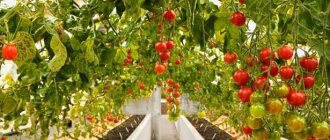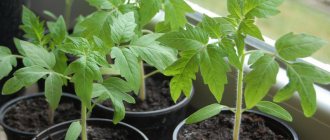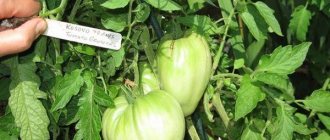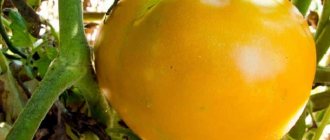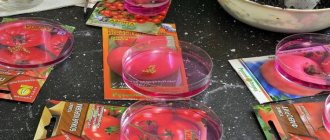Orange bison is a bright decoration for the site and a delicious salad dish on the table. Due to its huge size, orange color and shape, many people mistake it for a miracle pumpkin. Large fruits have become a favorite of many gardeners for their unique taste and high commercial properties.
| Height | Landing location | Ripening time | Fruit color | Fruit size | Origin | Fruit shape |
| Tall | Greenhouse, Open ground | Late ripening | Orange | Large | Variety | Flat-round |
Description
Among the main characteristics of tomatoes of the Bison orange variety:
- The variety is medium late - the harvest will appear in the last third of summer.
- Good immunity, high resistance to pests. Usually no additional protection is required, but only with proper care.
- More suitable for growing in greenhouses, but can also be grown in open ground.
- The shape of the fruit is round, almost without ribbing.
- The fruits are strong, so these tomatoes are ideal for canning.
- It goes well with other products and is suitable for preparing dishes - salads, soups, sauces, etc.
- From one bush you can collect up to 4 kg of fruit.
- The height of one bush reaches 160 cm; there is usually little foliage.
- The fruits are stored well and for a long time, and also tolerate transportation.
- The taste is sweet and does not change over time.
- The aroma is rich.
- The pulp is dense and juicy. Its color can be monochromatic, or it can have beautiful stains of different shades of orange.
The name is due to the rich color of the fruits, as well as their weight - approximately 500-900 grams each. Thus, tomatoes of the Bison orange variety, both inside and out, are very similar to small pumpkins, which makes them a decoration for any table, even when fresh.
Tomato Sugar bison
Tomato Sugar Bison is one of the most popular varieties among amateur gardeners and summer residents. The vegetable crop was developed not so long ago, in 2004, by Russian breeders led by V. Kochaynik. Having passed all the tests at a special site, the variety was included in the State Register of the Russian Federation.
The culture is intended for cultivation in open ground and in greenhouse conditions. The plant has many advantages over other similar crops. But to avoid low yield results, you need to know all the nuances of its cultivation.
Sugar Bison is a mid-season crop. The variety is indeterminate, in which the axial trunk is not limited in growth. On average, the height of the bush reaches 1.6–1.8 m. The plant is not very leafy, which contributes to good lighting of the fruits. The first ovary of 3–5 fruits is laid on the 6–7 leaf, followed by an interval of 1–2 leaves.
In one season, the crop yield is 8 kg. per 1 sq. m., from one bush to - 25 kg. The first ripening of a tomato occurs 90–111 days after germination.
General characteristics and description of the fruits:
- Tomatoes have a round shape, in rare cases heart-shaped.
- The weight of the first fruits is 300–400 g, and of the later ones - 200 g.
- At market ripeness, the tomato turns pink or crimson.
- The fruit pulp is dense, not watery, with a juicy sugar taste and a strong aroma.
The collected fruits can remain marketable for quite a long time, which is an excellent indicator for those summer residents who grow vegetables for sale.
The Sugar Bison has two subspecies, the Yellow Bison and the Black Bison. These varieties belong to the determinant type, that is, with limited growth of the bush. The cessation of growth occurs due to the flower brush, which is formed on the central trunk of the plant.
The following indicators are considered distinctive features of these varieties:
- The Yellow Bison has two main trunks, while the Black Bison has one powerful central stem.
- The color of the fruits of the Black Buffalo is a dark, purplish-violet hue. Yellow Buffalo has bright yellow or light orange fruits.
- Black Bison's tomatoes are endowed with a specific fruity taste, while its analogue has a sugar-sweet taste of the fruit.
- The fruits of the Yellow Buffalo are endowed with dense skin, while those of the Black Buffalo are thinner.
Otherwise, the varieties have a general similarity: they are flat-round in shape, weighing from 200 to 300 grams.
Similar varieties
Large-fruited indeterminate crops that are similar in quality to Sugar Bison include the following varieties:
- Abakan pink;
- Bull forehead;
- Bull's Heart;
- St. Andrew's surprise;
- Budenovka;
- Giant raspberry;
- Mazarin;
- Dulya.
Despite the general characteristics of ripening and fruit weight, the Sugar Bison variety has distinctive advantages and disadvantages.
Sugar Bison, like any other fruit crop, has both advantages and disadvantages. The advantages of the variety include the following indicators:
- high productivity;
- excellent taste;
- simultaneous ripening of fruits;
- uniform seed germination;
- drought resistance;
- good immunity to diseases;
- long shelf life of fruits.
It is also worth noting that the variety is universal. Its fruits can be used both fresh and processed.
The culture has no major disadvantages. The only significant disadvantage of the variety is that during growth it is often subject to gray rot.
Landing
Sugar Bison seed sowing begins in late February or early March. To plant, planting equipment and soil are prepared. It is better to choose wooden or plastic boxes as containers for seedlings.
The soil can be prepared in the fall from your own plot or purchased at the store. To increase seed germination, the soil must be rich in nutrients, loose, with a pH level of 6.2 to 6.8.
Having prepared everything necessary, the seeds are treated with a disinfecting solution and tested for germination. After this, landing is carried out in the following order:
- Furrows 1.5 cm deep are made in the soil located in the boxes.
- Tomato seeds are placed in them and poured on top.
- The box is watered using the drip method with warm water.
At the end of the planting work, the boxes are covered with polyethylene film and put away in a warm, dark place. After 5–6 days, when the sprouts begin to hatch, the boxes are moved to a well-lit place, having first removed the film from them.
When the first 2-3 leaves are formed on the plant, it is picked. The transplant is carried out in a new spacious place, with a lump of earth, without damaging the root system.
After 55–60 days, when the vegetable crop is completely strong, it is planted in a permanent place of growth.
According to the recommendations of experts, in the northern regions of the country, it is better to plant Sugar Bison in a greenhouse in early May, and in open ground in early June, when the air temperature at night is 11°C. In this case, the seedling must have a healthy appearance, without damage to the trunk or wilting of the foliage. If these requirements are met, the transplant process can begin.
To the greenhouse
One week before planting the Sugar Bison, the greenhouse needs to be prepared. To do this, the soil is well loosened and disinfected with a special solution. To prevent the root system of young plants from being damaged by the cool soil, beds are formed 35 cm high and 85 cm wide, which will have time to warm up under the sun's rays by the time of planting.
A week later, the following transplantation work begins:
- The location of the seedlings is marked on the ridge. To prevent adult plants from interfering with each other, the one-sided transplantation pattern should be 60x50 cm.
- Holes are dug in the designated places, 30 cm deep and wide.
- Fertilizers for nightshade vegetable crops are added to the pit.
- Fertilizers mix well with the soil.
- After pouring the hole well, the seedling is installed in it so that the root system is in the ground.
- The seedling is covered with earth, and a hole is formed around it for further watering.
In open ground
To plant Sugar Bison in open ground, choose a cloudy day. In order for the plant to take root well, the planting area needs to be dug up and cleared of weeds.
Next, the transplant is carried out according to the following scheme:
- The beds are prepared with a distance of 1 meter from each other.
- Stakes are driven into the edges of the beds.
- Lacing is stretched from one peg to another.
- Holes are dug along the rope at a distance of 50 cm from each other. The depth of the holes should be at least 20 cm.
- Seedlings are installed in the prepared holes so that the height of the seedling above ground level is about 15 cm. In this case, all lower leaves must be removed.
- The plant is covered with soil.
After planting, you must immediately water the seedlings with plenty of warm water and mulch the soil with rotted manure.
The first feeding for plant growth is carried out 2 weeks after transplantation with mineral fertilizers. After 10 days, it is recommended to repeat the procedure. Also, for the quality of the fruit, you will need to regularly add boron, zinc, magnesium and manganese.
To ensure that the roots of the plant are well saturated with air, the tree trunk circle is loosened once every 2 weeks.
Between loosening, you need to regularly remove weeds, which take nutrients from the soil.
The first watering carried out during transplantation will last for 2 weeks. Then the plant is regularly watered with warm water in dry weather. On cloudy days, watering is reduced to 2 times.
In order for the root system to provide the plant with sufficient nutrients, it is necessary to remove excess shoots and inflorescences on the main stem weekly.
Since Sugar Bison is a tall crop with large fruits, it must be tied to a stake or other support.
By following the rules of agricultural work, you can not only achieve a high yield, but also avoid various diseases that lead to the death of the plant.
Sugar Bison has good resistance to various diseases. However, under unfavorable conditions, it can still be susceptible to certain diseases.
To prevent infection, you need to plant seedlings without mechanical damage and at a maintained distance. If the plant is infected, it must be treated with fungicides.
To avoid this disease, it is not recommended to plant tomatoes close to potatoes. To combat the disease, you can use Bordeaux solution or garlic infusion.
In addition to these diseases, there are cases of plant death from pests. The most dangerous parasites for the variety are:
- mole cricket;
- whitefly;
- Colorado beetle;
- nightshade miner;
- spider mite
To combat these insects, you can use special chemicals, such as Intavir, Molniya, Actellik or Mitak.
The Sugar Bison variety has such tasty, sweet and aromatic fruits that they can be served either as light salads with other vegetables or as a separate fresh dish.
Due to their dense and juicy pulp, tomatoes are ideal for preparing hot dishes such as:
- classic gazpacho;
- tomato soup;
- pizza;
- hot sandwiches;
- sun-dried, stuffed tomatoes, etc.
The fruits are also ideal for preparing cold appetizers, natural juices and canning. If the year turns out to be fruitful, Sugar Bison tomatoes can be used for winter salads, pickles, cooking adjika and sauces.
In addition, some chefs have found an extraordinary purpose for the fruits of this variety, using them to make preserves and jams.
Having examined the characteristics of the Sugar Bison tomato variety, you can see for yourself that this crop is ideal for all regions of Russia.
Growing seedlings
At the beginning of spring, Bison orange tomato seeds need to be planted in special boxes. Watering is moderate (warm water, spray), any fertilizing suitable for tomatoes is useful. But there should be a lot of light and warmth:
- First, the temperature should remain stable at +15-17 degrees.
- When shoots appear, the temperature increases to +20.
As soon as the first normal leaves appear, picking is carried out.
By May the bushes will be ready to go into the ground. It is important not to miss the moment of planting, since the number of fruits, their quality and the health of the plant as a whole will directly depend on this.
In order for the seedlings to tolerate transfer to the ground well, they should be hardened off. To do this, it is simply kept in the fresh air, but where there are no drafts.
Growing rules
The Sugar Bison tomato is cultivated mainly in greenhouse conditions, but in areas with a hot climate it is possible to obtain a good harvest by growing the variety in open ground.
Planting seedlings
Nutritious soil is the basis for good seed germination. Soil for seedlings is purchased in specialized stores or made independently: humus, peat and soil are mixed in a ratio of 1:1:3.
The finished soil mixture must be disinfected with a solution of potassium permanganate and thoroughly heated in an oven.
Plastic containers, previously washed and disinfected, are used as containers for planting Sugar Bison. Peat containers can also be used.
Before planting, the raw materials of the variety are checked for expiration date, and damaged samples are removed. The seeds are disinfected and placed in a saline solution: only those that remain at the bottom of the container are used.
Tomatoes are sown in late February or early March. The prepared soil is moistened, grooves are made and raw materials are placed in them, and a little soil is sprinkled on top.
At the end of the procedure, the container is covered with film or glass and transferred to a warm room with good lighting. Shoots appear in 5–7 days.
After germination of tomato seeds, the containers must be placed in a room where the temperature is from 14 to 20 ° C
It is important to provide for the possibility of providing additional lighting in case of bad weather or frost
Moisten the tomatoes with a spray bottle, avoiding moisture getting on the leaves as the soil dries. After the appearance of 3 leaves, the Sugar Bison variety must be planted: planted in different containers, preserving the root system with soil when transferred to the soil.
7–10 days before planting in a greenhouse or open ground, it is necessary to take the tomatoes outside every day for 2–3 hours to harden them.
Tomato transplant
The optimal temperature for transferring Sugar Bison tomatoes is 16 °C. At night it should not be below 10°C outside. Tomato transplantation is carried out at the end of May or beginning of June.
Form a bed so that for 1 sq. m fit 3 seedlings. Peat and ash are poured into the finished hole, 20–25 cm deep. The plant is transferred to the prepared soil, sprinkled with soil on top and watered well.
Important! A distance of 40–45 cm is left between tomato seedlings, and the beds are placed every 50–60 cm. When planting tomatoes in greenhouse conditions, the soil is disinfected with a solution of potassium permanganate, dug up and fertilized 2 weeks before transplanting the seedlings into the ground
When planting tomatoes in greenhouse conditions, the soil is disinfected with a solution of potassium permanganate, dug up and fertilized 2 weeks before transplanting the seedlings into the ground.
Subsequent care for tomatoes
The mandatory stage of growing the Sugar Bison variety is watering, weeding and fertilizing. Violation of the rules of agricultural technology provokes the development of diseases in tomatoes and reduces the chances of getting a good harvest.
Tomatoes are watered with warm water every 3-5 days. Moistening the soil with rain or settled water has a beneficial effect on the plant. Saturate the ground with moisture in the morning or evening hours to prevent burns on the leaf plate.
After each watering, the Sugar Bison's soil must be loosened: the soil warms up faster, weeds are removed and air humidity increases. When ovaries form, the procedure is carried out less frequently to avoid traumatizing the tomato.
It is necessary to mulch the Sugar Bison variety with peat, dry straw or mulch. This will prevent the soil from drying out and reduce the intensity of weed growth.
Fertilizing of the Sugar Bison is carried out 14 days after transplantation, then before flowering, and after the formation of the ovary. Fertilize the soil with mineral or organic fertilizers. Fertilizer should be applied to the soil or dissolved in water. It is necessary to avoid getting liquid on the sheet plate.
If necessary, the tomato is hilled and tied up using metal structures or a trellis. It is necessary to ensure that the plant is fixed and the fruits do not lie on the ground. As the tomatoes grow, it is possible to re-tie the clusters with fruits and the main stem.
Landing in the ground
Transplantation into the ground occurs in May, but before that the ground needs to be properly prepared:
- Build a greenhouse if it is film.
- Make spilled depressions of 5-8 cm.
- The soil must be loosened before planting.
- The distance between plants is 40 cm.
- The distance between rows is 60 cm.
Since the bush will be tall, you should immediately take care of a support for each bush. Moreover, the brushes will be thinner than required for fruits of this size, so they will also need to be tied up. It is better to prepare wooden supports in advance so that the fruits do not destroy the bushes during the ripening process - according to reviews from gardeners, weak and low-quality supports will definitely break.
The Orange Bison variety is comfortable with mulching with a special fabric or film to increase productivity. However, the support system in this case must be thought out correctly.
Care
The bushes require moderate and regular watering until the fruits begin to appear. At this moment, watering should become more abundant, and the soil should also be loosened frequently so that it is saturated with air and the water does not stagnate. Mineral fertilizers are also required; you can purchase any balanced complexes without making anything yourself. This is also one of the advantages of this variety in terms of care.
The bushes are formed into 2 trunks; pinching is mandatory to maintain the plant’s immunity.
Since this variety is very heat-loving, you will need to make sure that it has a lot of light. The taste of the fruit will depend on how well the planting site is lit. The lack of light and sun makes not only the color less saturated, but also the taste more bland. Often fruits that have not received enough light may be yellow.
We can talk about harvesting 4 or 4.5 months after the seedlings were made. That is, tomatoes will be ripe at the end of July and beginning of August.
Having harvested the crop, you can immediately use it for harvesting, since August is the time to can tomatoes, as well as salads made from them and soup dressings. This is also the time to make homemade ketchups and adjikas, and Bison Orange is also perfect for them.
Agrotechnics of cultivation
When growing planting material, take into account climatic conditions and the form of plant cultivation (greenhouse, open ground). Bushes planted with a delay will bear fruit worse, and their immunity to diseases and pests is reduced.
Anyone who has planted a crop and grown planting material on their own recommends soaking the seeds for several days, wrapping them in cloth. This event will allow you to get friendly shoots.
To grow healthy seedlings, seedlings are provided with heat and light. The optimal temperature for hatched seeds should be +15-17 °C. After the shoots grow, the temperature is increased to +20-22 °C.
Seedlings require moderate watering, for which it is better to use warm water. It is recommended to moisten the soil using a sprayer. After the formation of the first true leaves, picking is carried out.
Feeding seedlings is an important activity that provides the crop with nutrients. Timely application of complex fertilizers contributes to the formation of a strong plant, which will have a positive effect on crop productivity.
To quickly adapt the plant to external conditions when transplanting to a permanent place, the planting material is hardened. When cultivating the variety, you need to take into account that this tomato loves sunlight very much. This is reflected in the taste.
See also
Description of the large beef tomato Orange Giant and features of growing the variety
Read
With maximum light, the fruits become sweeter, so it is recommended to cultivate the variety on the sunny side. To increase crop productivity, it is recommended to mulch using special fabric.
The bushes require garter immediately after transplantation. Additional support must be reliable to avoid deformation of the stem under the weight of the fruit. To grow healthy tomatoes, it is necessary to form bushes into 2 trunks and remove the stepsons.
During the growing season, hilling is carried out, watered regularly, and mineral fertilizers are applied. A mandatory step is to loosen the soil near the root system to ensure a balance of moisture and air.

